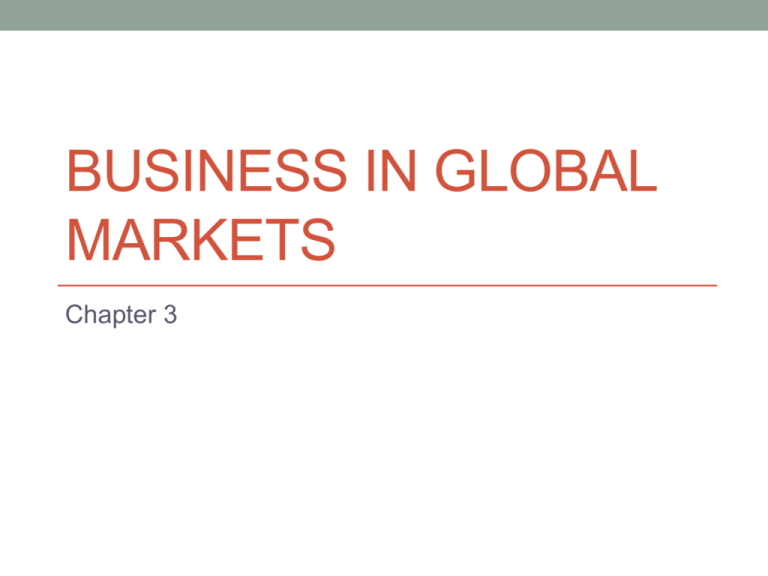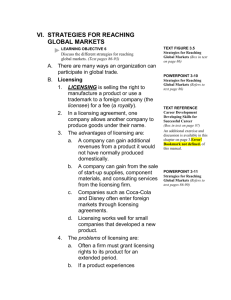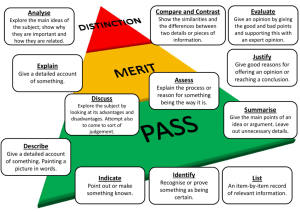Business in Global Markets
advertisement

BUSINESS IN GLOBAL MARKETS Chapter 3 Learning objectives 1. Define global business. 2. Understand the importance of global trade. 3. Discuss the roles of comparative and absolute advantage in global trade. 4. Discuss the two indicators for measuring global trade. 5. Discuss the different strategies for reaching global markets. Understanding Globalization • Global business • It refers to any activity that seeks to provide goods and services to others across national borders while operating at a profit. • Cultural changes: companies face new cultural challenges when they engage in international business 4 Global Trade • US vs. Global Market • Most companies cite global expansion as a link to its future growth. • Global market is attractive to large and small businesses alike. • Exporting:- is selling products to another country. • Importing:- is buying products from another country. 5 Why Trade Globally? • Countries trade with other countries for several reasons • • • • such as : No nation what so ever can produce all of the products that its people want and need. Even if a country becomes self-sufficient other nations would seek to trade with that country in order to meet the needs of their own people. Some nations have an abundance of natural resources and a lack of technological know-how, while others have sophisticated technology but few natural resources, Free trade:- is the movement of goods and services among nations without political or economic trade barriers. 6 Comparative Advantage and Absolute Advantage • Global Trade :- is the exchange of goods and services across national borders • Comparative Advantages Theory :- A country should sell to other countries those products that it produce most effectively and efficiently → and buy from other countries those products it cannot produce as effectively or efficiently. • Every country has a comparative advantage in something • Absolute advantage :- it happens when a country has monopoly on producing a specific product or is able to produce it more efficiently than all other countries. 7 Measuring Trade Balance of Payments and Trade Deficits To measure the effectiveness of global trade → nations follow two key indicators:- balance of trade & balance of payment. Balance of Trade :- is a nation’s ratio of exports to import. Balance of payments:- is the difference between money coming into a country (from exports) and money leaving the country (for imports) 8 Measuring Trade • Unfair trade practices • Unfair trade Practices is one of the concerns in measuring • • • • trade, and many countries are enforcing laws to prohibit these practices. There are mainly two unfair trade practices: Dumping: selling products in a foreign country at lower price than those charged in the producing country. Sometimes dumping can include selling products in a country below what it cost to produce the product. The Gray Market:- refers to the flow of goods in a distribution channel or channels other than those intended by the manufacturer. 9 Strategies for Reaching Global Markets • There are several strategies a business can use to enter the global market. 10 Strategies for Reaching Global Markets • Licensing • a company may decide to go global by licensing the right to manufacture its product or use its trade mark to a foreign company for a fee ( a royalty). • agreement is simply one where a company allows another company to produce goods under their names. 11 Strategies for Reaching Global Markets Exporting • Export Assistance Centers (EACs) • Organizations may start exporting or selling their goods to other countries • Export trading companies may help companies with a risky part of getting paid for their goods 12 Strategies for Reaching Global Markets Franchising • Franchise Agreement (Franchisor & Franchisee) • Product adaptation • An arrangement where by someone with a good idea for a business sells to others the right to use the business name and sell the product or service in a given territory. 13 Strategies for Reaching Global Markets • Franchising • Franchising is different from licensing in that where licensing might be for a single product, franchising allows the use of an entire concept including the label, how the good is manufactured or made, and the look and feel of the business • US franchisors such as McDonald’s, 7-Eleven etc have many global units operated by foreign franchisors • Franchisors have to be careful to adapt their product or service to the countries they serve. 14 Comparaison chart Governed by Registration Territorial rights Franchising Securities law Required Offered to franchisee Support and training Provided by franchiser Royalty payments Use of trademark/logo Yes Logo and trademark retained by franchiser and used by franchisee McDonalds, Subway, 7-11, Dunkin Donuts Franchiser exercise control over franchisee. Examples control Licensing Contract law Not required Not offered; licensee can sell similar licenses and products in same area Not provided Yes Can be licensed Microsoft Office licensor does not have control over licensee 15 Strategies for Reaching Global Markets • Contract manufacturing involves a foreign company’s • • • • production of private label goods to which a domestic company then attaches its own brand name or trademark. The practice is also known as outsourcing. Contract manufacturing enables a company to experiment in a new market without incurring heavy start-up costs such as a manufacturing plant. A firm can also use contract manufacturing temporarily to meet an unexpected increase in orders. One of the major disadvantages is that intellectual property and copyright laws are different in every country 16 Strategies for Reaching Global Markets • International Joint Ventures and Strategic Alliance • • • • • Joint ventures is a partnership in which two or more companies (often from different countries) undertake a major project. Joint ventures can be used by governments as a condition of doing business in their country It can be used as a way of getting into countries, eg China Joint ventures can be developed for reasons such as expanding the market for a low selling product in the home country They can also be used to share technology 17 Strategies for Reaching Global Markets • Greenfield Investment • This is an alternative to a joint venture • A Greenfield investment is when a company decides to enter a country and build offices and production facility • The major disadvantage here is that there may be lack of knowledge of the country’s ways of doing business • A Greenfield investment is a form of foreign direct investment (FDI) 18 Strategies for Reaching Global Markets • Strategic Alliances • This is an agreement between two or more companies to work together to achieve competitive market advantages • It is a long term partnership between two or more companies established to help each company build competitive market advantages • These alliances can help provide access to markets, capital and technical expertise 19 Strategies for Reaching Global Markets • Foreign Direct Investment (FDI) • is the buying of permanent property and business in foreign nations. • As the size of the market expands, many firms increase foreign direct investment and establish a foreign subsidiary 20 Strategies for Reaching Global Markets • Foreign Subsidiary:- is a company that is owned in foreign country by the home company (called the parent company). • This company would operate like a domestic firm in the foreign nation, with production, distribution, promotion, pricing and other business functions under the control of the foreign subsidiary’s management • The legal requirements of both the country where the parent firm is located (called the home country) and the foreign country where the subsidiary is located (called the host country) have to be observed 21 Strategies for Reaching Global Markets • The major advantage of a foreign subsidiary is that the • • • • home company maintains complete control over any technological or expertise it may possess. The major shortcoming : The parent company is committed to a large amount of funds and technology within foreign boundaries Should relations with the host country go bad the firm’s assets could be taken over by the foreign government Such a takeover is called ‘expropriation’ Creating a subsidiary might not be the best course of action for a small business; as a company grows it may be possible. 22 Strategies for Reaching Global Markets • Expropriation • When a host government takes over a foreign subsidiary in a country • This can happen if relations with the host country go bad. They will take over the assets of the foreign company 23 Strategies for Reaching Global Markets • Multinational corporartion • This is an organization that manufacturers and markets products in many different countries. It has multinational stock ownership and multinational management • These are extremely large corporations, but not all large firms involved in global businesses are multi nationals • Only firms that have manufacturing capacity or some other physical presence in different nations can truly be called multinationals








